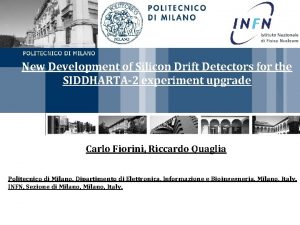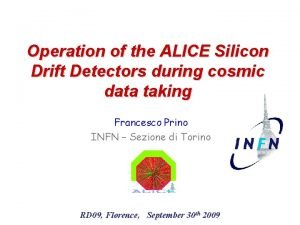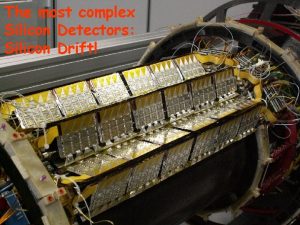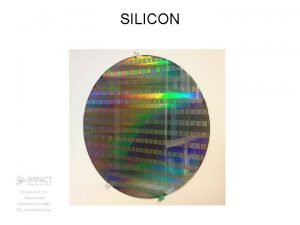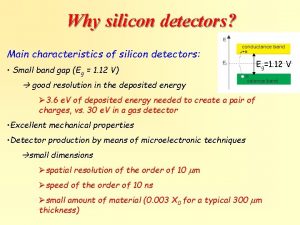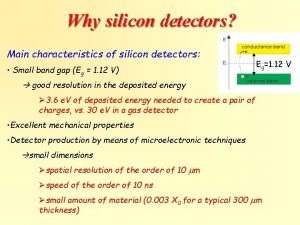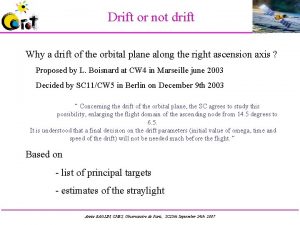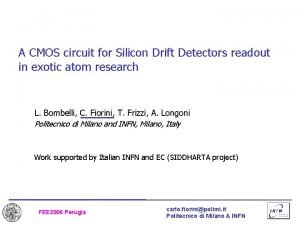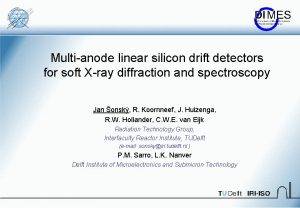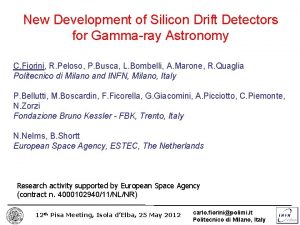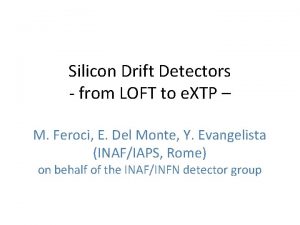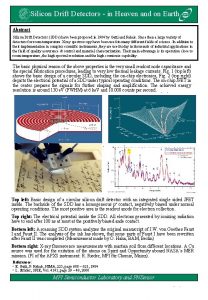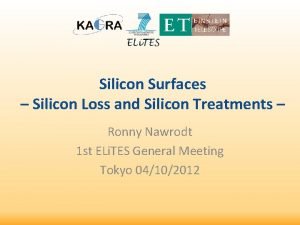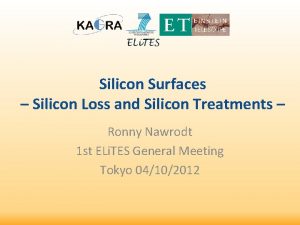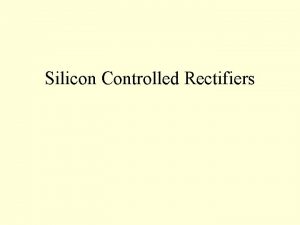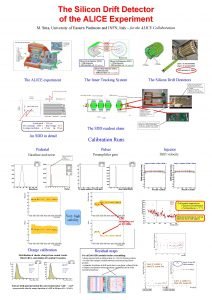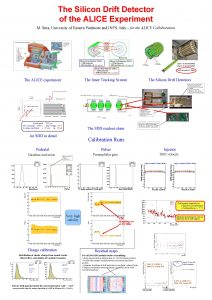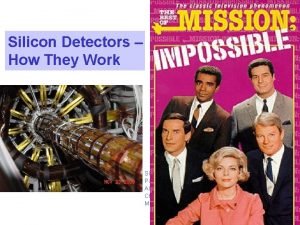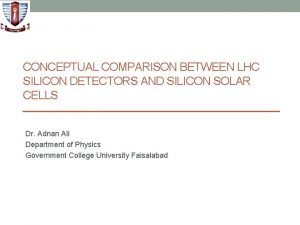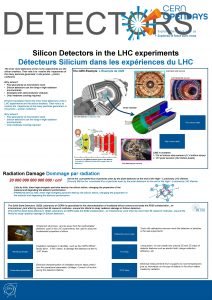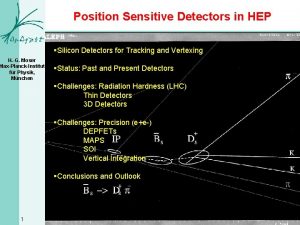Operation of the ALICE Silicon Drift Detectors during































- Slides: 31

Operation of the ALICE Silicon Drift Detectors during cosmic data taking Francesco Prino INFN – Sezione di Torino RD 09, Florence, September 30 th 2009

SDD sensor 120 mm pitch Central Cathode at -HV 291 Drift cathodes Voltage divider 70. 2 mm 256 x 2 Anodes Edrift vd (e-) HV, MV supply 294 mm pitch Electron potential in SDD LV supply Commands Trigger Data Hybrid with front-end electronics (4 pairs of ASICs) 2

SDD Front-end electronics PASCAL c. Preamplifier c. Analog Storage ü Analog Memory sampled at 40 MHz (default) or 20 MHz c. Conversion Analog->digita. L ü 10 bit ADC AMBRA c. Digital multi-buffer c. Anode-by-anode baseline equalization c. Non-linear data compression ü From 10 to 8 bit 3

SDD ladders and layers Layer # Modules ladders /ladder # modules Material Budget (% of X 0) 3 14 6 84 1. 13 4 22 8 176 1. 26 CARLOS board c 8 inputs fed in parallel by 8 AMBRAs ü 1 Carlos per SDD module c 2 D 2 -threshold zero suppression c Formats data and sends to DAQ 4

Cooling the SDD Cooling agent: water Pressure inside barrel <1 bar c Leak safe Flow adjusted to stay in intermediate state between laminar and turbulent regime c Maximum heat exchange 13 (sectors) * 2 (A/C side) *2 (Ladder/End-ladder)circuits with independent flow and pressure control Safe operation controlled by dedicated Programmable Logic Controller: c Overpressure control to guarantee leak safety c Flow control to give the clearance for FEE operation. 5

SDD Detector Control Systems controlled by DCS: c LV power for Front-End Electronics c HV and MV supplies for SDD detectors c Cooling plant c State of readout cards Finite States Machine (FSM) provides simple control of the whole system by well defined sequence of states c FSM communicates to DAQ and gives permission to start data-taking when detector is in ready state c Alarms and warnings logging system c Archiving of all system parameters ü HV, MV, temperature recorded by thermistors … 6

Readout and DAQ Online Monitoring Layer 4/C 1 Global Data Concentrator Layer 4/A SDD: 260 modules Layer 3 DAQ control in Counting Room 24 CARLOSrx VME boards 6 Local Data Concentrators (PCs) Each CARLOSrx board: c. Uploads configuration to CARLOS/AMBRA/PASCAL (JTAG) c. Sends trigger to CARLOS and busy to CTP c. Reads data from up to 12 modules, apply data format compression and sends to DAQ Mass storage (CASTOR) 7

Running conditions Detector characteristics: Parameter HV (central cathode) MV (cathode 291) Cathode 291 Value Edrift 1800 V 40 V Drift field 500 V/cm Resolution (z x r ) 25 x 35 mm Readout and DAQ parameters c 245 (out of 260) modules stably in DAQ Parameter 20 MHz AM sampling 40 MHz AM sampling 50 ns 25 ns Number of time samples 128 256 Busy time 1 ms 2 ms Max. event rate 1 k. Hz 500 Hz Event size (cosmics) 12 k. B 25 k. B Time bin size 8

Calibrating the SDD Three SDD specific calibration runs collected every ≈24 h to measure calibration parameters c. Run Type: PEDESTAL ü Analyzes special SDD calibration runs taken without zero suppression ü Provides: Baselines, Noise, Common Mode Corrected Noise, Noisy anodes c. Run Type: PULSER ü Analyzes special SDD calibration runs taken with Test Pulse signal to frontend electronics ü Provides: Anode gain, Dead anodes c. Run Type: INJECTOR ü Analyzes injector events collected every ≈ 10 min. during physics runs ü Provides Drift speed (anode dependent) A detector algorithm (DA) runs automatically at the end of each calibration run c. Analyzes raw data and extracts relevant calibration quantities c. Files with calibration parameters are stored in the Offline Condition Data. Base and used in the offline reconstruction 9

Pedestal runs Measure for each anode: c. Baselines ü Extract baseline equalization constants applied anode-by-anode in AMBRAs c. Noise (raw and common mode corrected) Tag noisy anodes 10

Pedestal results vs. time (2008) Signal from MIP close to anodes ≈ 100 ADC counts 11

Pulser runs in 2008 Measure gain for each anode sending Test Pulse to the input of front-end electronics c Used for anode-by-anode gain AM sampling at 40 MHz AM sampling at 20 MHz equalization in cluster finder Test Pulse Signal 12

Drift speed from injectors From INJECTOR runs (acquired every 24 hours) c 33 x 3 MOS charge injectors Display of 1 injector event on 1 drift side of 1 module implemented in known positions on each drift side (half-module) ü 33 determinations of drift speed along anode coordinate for each drift side c. Drift speed extremely sensitive to temperature ( T-2. 4) ü 0. 8%/K variation at room temperature Drift speed on 1 drift side from fit to 3 injector points c. Need 0. 1% accuracy on drift speed to reach the design resolution of 35 mm along rf vdrift = m. E T-2. 4 Lower e- mobility / higher temperature on the edges 13

Drift speed vs. module Drift speed (electron mobility) depends on: c. Temperature ü Higher drift speed on average on Layer 4 Lower temperature on layer 4 ü Estimated temperatures ≈ 24 C on Layer 3 and ≈ 21 C on Layer 4 c. Doping concentration (to a much lesser extent) ü Resistivity: 3000 -4000 cm Doping concentration ≈1. 2 -1. 5 1012 cm-3 Layer 4 14

Drift speed stability – first test Short term stability c. Check stability during ≈ 1 hour, rate ≈ 2 triggers/minute c. Fluctuations: r. m. s. /mean ≈ 0. 07% Mon, 03 Mar 2008 23: 51: 32 GMT Tue, 04 Mar 2008 01: 05: 26 GMT 15

Drift speed stability in 2008 Long term stability c 3 months of data taking during summer 2008 c. Drift speed stable within 0. 2% Layer 3, Ladder 6, Mod 275, Anode 200 July 11 th 2008 Layer 3 off less heating October 14 th 2008 Layer 4, Ladder 14, Mod 428, Anode 200 16

SDD timing Start-Of-Payload delay (= the number of clock-cycles after which the AM is frozen and read-out) c. Tuned to accommodate the 5. 4 ms of max. drift time into the 6. 4 ms time window defined by the memory depth c. Done with SOP delay scans during LHC injection tests with beam (bunches of 5 109 p at SPS energy) dumped close to ALICE 17

Analyses on cosmic data sample Statistics collected with SPD Fast. Or trigger: Talk by G. Aglieri c 2008: ≈ 105 good cosmic tracks with full ITS, without B-field c. Goal for 2009: ≈ 105 tracks with B-on + 105 tracks with B-off Goals from analysis of cosmic data: c. Align the 2198 ITS sensors with precision < than their resolution ü Specific for SDD: calibrate the Time Zero ü Time Zero = time after the trigger for a particle with zero drift distance cd. E/dx calibration in SDD and SSD Statistics collected on Layer 4 18

Time Zero – method 1 Cosmic track fitted in SPD and SSD layer Track-to-point residuals along drift coordinate in the two drift regions of each SDD module c Show opposite signed peaks in case of mis-calibrated time zero c Time. Zero = Delta. Xlocal / 2. / vdrift = 434± 6 ns ü NOTE: preliminary value for 2009 data, averaged over all modules of layer 4 side A ry ry a n mi i l e r EP na i m eli r P E C I AL Xlocal residuals (cm) IC AL Xlocal residuals (cm) 19

Time Zero – method 2 Extract Time. Zero from the minimum measured drift time for SDD reconstructed points associated to tracks c PROS: no dependence on SDD calibration parameters (drift speed) c CONS: requires more statistics c First results from 2009 data analysis look promising ü Time. Zero from fit with error function of the rising edge = 434 ns (Layer 4 side A), BUT errors very large ry ina m i el r P E C I AL 20

Geometrical alignment of SDD Interplay between alignment and calibration c. Time. Zero for each module included as free parameter in Millepedebased alignment together with geometrical rotation and translation ü Drift speed added as fit parameter for modules with mal-functioning injectors c. Resolution along drift direction affected by the jitter of the SPD Fast. OR trigger (at 10 MHz 4 SDD time bins) with respect to the time when the muon crosses the SDD sensor Geometry only Geometry + calibration 21

Charge calibration (I) Cluster charge distribution fitted with Landau+Gauss convolutions Most Probable Value of collected charge depends on drift distance/time c Larger drift distance larger charge diffusion wider cluster tails cut by the zero suppression 22

Charge calibration (II) Cross check with cosmics collected on few SDDs in test station with and without zero suppression c. Data without zero suppression show no dependence of Landau MPV on drift time/distance Apply linear correction of charge vs. drift time to cosmic data collected in 2008 by ALICE c. Correction extracted from detailed MC simulations of SDD response 23

Conclusions SDD successfully operated during ALICE cosmic data takings in 2008 and 2009 c 245 SDD modules (out of 260) stably in acquisition during both the data takings, fraction of good anodes > 97. 5% c Calibration strategy deeply tested and tuned ü Good knowledge of the detector reached ü Noise level within the design goal (S/N for MIP close to anodes ≈ 50) ü Drift speed stable with 0. 2% during stable operation of ITS detectors Results from cosmic data sampled allowed for c Develop tools for attacking the SDD alignment which is correlated with calibration quantities ü Tuning of Time. Zero module-by-module using Millepede ü Recovering drift speed for modules with mal-functioning injectors c Calibrate the charge collection efficiency as a function of drift time ü Good results by applying the correction based on MC simulation of Zero Suppression algorithm SDD ready for the forthcoming p-p collisions at LHC 24

Backup 25

Inner Tracking System Design goals c. Optimal resolution for primary vertex and track impact parameter ü Minimize distance of innermost layer from beam axis (<r>≈ 3. 9 cm) and material budget c. Maximum occupancy (central Pb. Pb) < few % c 2 D devices in all the layers cd. E/dx information in the 4 outermost layers for particle ID in 1/b 2 region Layer Det. Type Radius (cm) Length (cm) 1 SPD 3. 9 2 SPD 3 Resolution (mm) Pb. Pb d. N/dy=6000 rf Z Part. /cm 2 Occupancy (%) 28. 2 12 100 35 2. 1 7. 6 28. 2 12 100 12 0. 6 SDD 15. 0 44. 4 35 25 3 2. 5 4 SDD 23. 9 59. 4 35 25 1. 0 5 SSD 38. 0 86. 2 20 830 0. 6 4. 0 6 SSD 43. 0 97. 8 20 830 0. 45 3. 3 26

ITS Commissioning data taking Detector installation completed in June 2007 Run 1 : December 2007 c. First acquisition tests on a fraction of modules Run 2 : Feb/Mar 2008 c≈ 1/2 of the modules in acquisition due to cooling and Installation of services completed in May 2008 Run 3 : June/October 2008 c. Subdetector specific calibration runs TIME power supply limitations c. Calibration tests + first atmospheric muons seen in ITS ü Frequent monitoring of dead channels, noise, gain, drift speed … c. Cosmic runs with SPD Fast. OR trigger ü First alignment of the ITS modules + test TPC/ITS track matching ü Absolute calibration of the charge signal in SDD and SSD Run 4 : started on mid August 2009 27

SDD correction maps All the 260 SDD modules have undergone a complete characterization (map) before assembling in ladders c. Charge injected with an infrared laser in > 100, 000 known positions on the surface of the detector c. For each laser shot, calculate residual between the reconstructed coordinate and the laser position along the drift direction c. Systematic deviations due to: ü Non-constant drift field due to non-linear voltage divider ü Parasitic electric fields due to inhomogeneities in dopant concentration Ideal Module Non-linear volt. divider Dopant inhomogeneties 28

Drift speed vs. time Layer 3, Ladder 6, Mod 275, Anode 200 July 11 th 2008 October 14 th 2008 29

SDD during 2009 cosmic run SDD constantly took cosmic data from Aug 17 to Sep 13 c 93% of modules included in DAQ c. Fraction of good anodes in the good modules = 97% c<Event size> ≈ 10 k. B / event (@ 20 MHZ AM sampling) ü Factor 50 improvement w. r. t. 2008 Total number of anodes = 133120 30

ITS Alignment Two track-based methods to extract the alignment objects (translations and rotations) for the 2198 ITS modules: c Millepede (default method, as for all LHC experiments) ü Determine alignment parameters of “all” modules in one go, by minimizing the global c 2 of track-to-points residuals for a large set of tracks c Iterative approach ü Align one module at a time by fitting tracks in the other modules and minimizing the residuals in the module under study Plus and hardware (based on collimated laser beams, mirrors and CCD cameras) alignment monitoring system c Monitor physical movements of ITS with respect to TPC Strategy for the track-based alignment: c Use geometrical survey data as a starting point ü Measurements of sensor positions on ladders during SDD and SSD construction c Hierarchical approach: ü Start from SPD sectors (10) , then SPD half staves (120), then SPD sensors (240) ü After fixing SPD, align SSD barrel (w. r. t. SPD barrel), then SSD ladders (72) … ü After fixing SPD and SSD, move to SDD (which need longer time for calibration) c Include SDD calibration parameters: ü Time Zero = time after the trigger for a particle with zero drift distance ü Drift speed for modules with mal-functioning injectors 31
 Silicon drift detector explained
Silicon drift detector explained Silicon drift detector principle
Silicon drift detector principle Nuclear detectors
Nuclear detectors Feature detectors
Feature detectors What is streaming potential
What is streaming potential Where are feature detectors located
Where are feature detectors located Detectors used in hplc
Detectors used in hplc Frontier detectors for frontier physics
Frontier detectors for frontier physics Vhv voltage detectors
Vhv voltage detectors Kinesthesis and vestibular sense
Kinesthesis and vestibular sense Giant gravitational wave detectors hear murmurs
Giant gravitational wave detectors hear murmurs Giant wave detectors murmurs universe
Giant wave detectors murmurs universe Diagnosing error in object detectors
Diagnosing error in object detectors Photo detectors
Photo detectors Feature vectors
Feature vectors What is thermal detector
What is thermal detector Một số thể thơ truyền thống
Một số thể thơ truyền thống Thế nào là hệ số cao nhất
Thế nào là hệ số cao nhất Hệ hô hấp
Hệ hô hấp Frameset trong html5
Frameset trong html5 Số.nguyên tố
Số.nguyên tố đặc điểm cơ thể của người tối cổ
đặc điểm cơ thể của người tối cổ Mật thư tọa độ 5x5
Mật thư tọa độ 5x5 Các châu lục và đại dương trên thế giới
Các châu lục và đại dương trên thế giới Glasgow thang điểm
Glasgow thang điểm ưu thế lai là gì
ưu thế lai là gì Thẻ vin
Thẻ vin Tư thế ngồi viết
Tư thế ngồi viết Cái miệng xinh xinh thế chỉ nói điều hay thôi
Cái miệng xinh xinh thế chỉ nói điều hay thôi Các châu lục và đại dương trên thế giới
Các châu lục và đại dương trên thế giới Bổ thể
Bổ thể Từ ngữ thể hiện lòng nhân hậu
Từ ngữ thể hiện lòng nhân hậu
